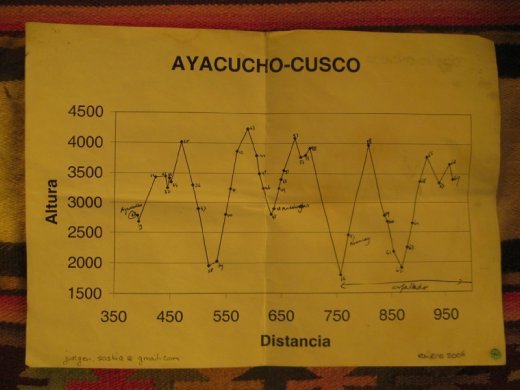Recuay to Ayacucho
14th of may - 9th of june 2010
866 km
link to photo gallery on picasa
Our bikes are looking flash: new tyres, grips, and blinking clean. Ready for another beating in the Peruvian Andes.....
We leave Recuay and our friendly hosts Werner and Maria on a sunny morning, to ride into Huascaran National Park nearby. The air is thin at 4100 meters and we are a little unaccustomed to riding loaded bikes (extra loaded with Dutch and Australian goodies...), so we keep the day short and camp at the Carpa ranger station.
Close to this station is a stand of Puya Raymondii, the biggest plant of the bromeliad family, and we use the next day to visit them and get more acclimatized to the altitude which we are feeling in our breathing. Puya Raymondii only flower once every 40 to 100 years and die soon afterwards. Last November a large number of them have flowered, and the big flower stalks are still on top of the dying plants. There are hundreds of birds living in this forest, one of them is the ‘pito’, or ‘carpintero’, a species of woodpecker. They hammer nests into the stalks and we watch one going in and out its hole to feed its young.
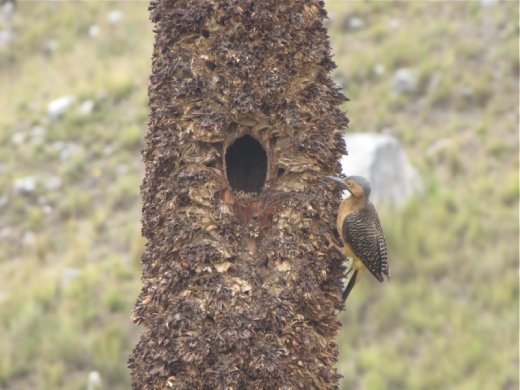
There is hardly any traffic in the park on the Pasto Rori road, and for two days we ride on quiet gravel roads between 4100m and 4800m amongst rocky peaks and glaciers almost descending onto the road.
A condor drifts on the afternoon thermals, its fingers spread.

A fisherman sells us two small trout which we carry for the day and prepare that night at our highest camp so far at 4650 meters. We now carry two stoves because the old one had been spluttering a bit and we were worried not being able to cook at high altitudes. It sure makes for quick cooking with two which is needed as the ensuing darkness brings the freezing cold. Soon after dark the clouds rush in and bring light rain. By early morning the sound of rain has been replaced with the damp thud of wet snow.
The next morning we wake up to a white world, as a bit of snow has fallen overnight.
Our campsite has changed from green to white.


We ride over 4800 meters 3 times that day past snow covered hills, mountain glaciers, awesome folded rock formations, a couple of nervous vicuñas and views of the Cordillera Huayhuash!


From the park exit we join the paved highway just below the high pass of Abra Yanashalla and descend a freezing cold downhill in hail and rain, down through a spectacular valley and gradually warming up as we get at lower elevation to the town of Huallanca.
We park the bikes for a day in a town called La Union and walk to Huánuco Viejo, Incan ruins on the pampas (grass plains) above La Union. Huánuco Viejo consists of a central religious building or Ushnu, built of big trapezoidal blocks of stone without using cement. Besides the Ushnu there are many stone buildings and walls and part of an Incan road from Cuzco to Cajamarca that has been cleared of its overgrowing grass. When I look at an Incan building like this Ushnu I feel overwhelmed by the thought ‘how on earth did they get those stones carved like that?’, and ‘how did they lift them on top of one another?’. I guess the same goes for Machu Picchu and Ingapirca and many other Incan ruins.

From La Union the road continues to Chavinillo. A friendly farmers family waves us down and offers to have their photos taken. We exchange some printed photos and they give us dried corncobs as lucky charms.

The presidential elections will be held at the end of the year, and most of the houses are painted promoting different parties and their members.

Some police officers stop to great us and advice us to eat Tokosh, a local specialty that would be good for energy and stomach and prostrate problems. All food here seems to have some medicinal benefit. In the next village we ask for Tokosh and are sat down in a small dark kitchen. The lady fills up two deep plates of something that looks like soup. We try a spoonful. Yuk, that’s absolutely horrible. What is it? We ask the lady what the source is of the Tokosh and she shows us a bucket full of rotting fermenting potatoes. Proudly she says ‘they are one year old!’. We try a few more spoons full but it’s really too much to bear. Luckily our neighbour is happy with an extra plate and scoops the tokosh away like a delicacy, laughing at the fact the gringos don’t like it. They can have it!
We continue on to Huánuco, and the infamous descent to this city. The past months we have puzzled together our route by reading blogs of other cyclists, and 4 of them have had a crash on the downhill to Huánuco. Extra careful thus we ride down. But the road has been graded in the past two years, and except for some very loose corners the road is pretty good. We even get lucky for the last bit, where they are paving the road and there is a roadblock. All the cars that have passed us since 8 am are waiting in a long row. We lucky cyclists can pass through, and have the next 20 km to ourselves. Bliss!! Bikes - Cars: 1-0. Amazingly the newly paved road already has potholes and is so narrow and curvy that we can´t but think of the crosses that will be on the roadside in the years to come.
From Huánuco the road deteriorates to a potholed highway climbing up to the Peruvian altiplano. Cars trying to dodge the holes approach from ´our side´ at high speed and scream ‘gringos’ or other taunts at us from their windows. A welcome relief are our mp3 players, the music shuts out the constant yelling and the climbing gets easier pedaling in the rhythm.
We search for a campsite next to a small lake before a pass at 4150m as described in another cyclists Pete´s notes (http://andesbybike.blogspot.com), he and Jude passed through here a year ago. We are tired after a long day of climbing and it’s very cold and raining. At last we see a lake. It more like a swamp scattered with Peruvian litter, but there are herds of nervous alpacas returning home to the corrals above us, and there is some flat space up a dirt track away from the highway so we pitch. The rain stops after everything is soaked but before we have been able to catch fresh water with the tarp, and I dream of fresh mountain springs and wake up thirsty the next morning. We have to use the swamp water. It tastes pretty bad and our spirits are somewhat dampened.

Lucky it’s a sunny day and we ride over the pass (and see Pete’s lake, unlike the swamp a very scenic place, a couple kms further along the road....yes complete with andean geese and herds of alpacas!) and onto the vast altiplano with lake Junin in the distance.
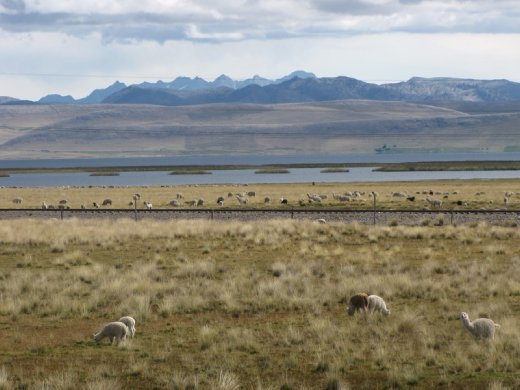
This area is well known for Maca. Maca is a root vegetable, that is dried and then ground to a powder. The powder has high energetic properties and is rich in vitamins. We mix it with oats to make a special porridge mix for breakfasts. It is sold all over Peru but the altiplano around Junin is where most of it is produced so the villages are lined by stands selling ‘especial de maca’. In one town there is even a ‘Giant Maca’ in the good old Australian fashion, this one is a giant purple maca root on the Plaza de Armas of Huayre.


After the Junin plains we gradually descend on paved roads from the altiplano following the railway line to Huancayo and dropping from 4200m to 3200m over two days riding, for the first time doing near 100 km days in Peru. We pass La Oroya, a mining town. Our notes warned us of the terrible pollution and traffic around this town, but the mine has been shut since november (due to environmental conditions that the US owned mine ‘Doe Peru’ has not been able to achieve over recent years), and as a result the town is very quiet. The rocks and rock formations around town are spectacular.
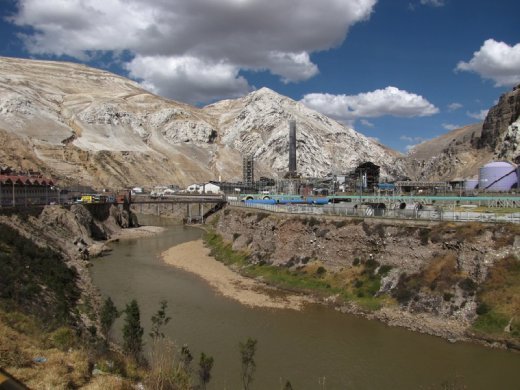
In Huancayo we take a couple of rest days. I do weaving classes with two indigenous women, Margareta and her daughter Mercedes. They are from Ayacucho and teach me ‘backstrap band weaving’, a bit similar to what I did in Guatemala, but now the pattern is on both sides. The backstrap is very small, and will still take weeks/ months to finish, but is easy to take along on the bike. I hope to do more weaving classes on the way down.
From Huancayo there are a few options to ride to Ayacucho. We opt for a backroad through Huancavelica and Lircay, described by Pete.
The road is gorgeous and quiet. It climbs from Huancayo to a pass, back down to Izcuchaca, up and down to Huancavelica and then over two 4200+ passes to Lircay, another 4500 meter pass and then down and up and down to Ayacucho.
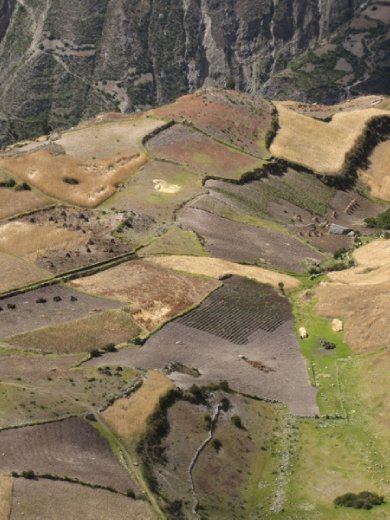
Huancavelica is a pretty town with some colonial churches and lots of coca. It’s sold 1 sol per ounce. The women selling it also sell black balls of calcium paste, which is chewed in combination with the coca, to make the effects stronger. Their mouths are black-greenish, teeth missing, bits of black and green discolouring their chins. We don’t like the taste of the leaves but have been using them to brew tea. They say the coca helps with breathing and exercise at altitude. It feels a bit like the effect of coffee, and makes you forget about time.

From Huancavelica after a big day of climbing up to 4200m over 20km and then up and down around the 4200m mark for the next 17km or so things turn a bit nasty. It’s already late when we find a spot to camp. That ‘lovely green spot of grass’ on the puna turns out to be a field of cactus-like grass, but it’s too late to find another place, and it seems that this grass is all around anyway. In order not to get our tent and mattresses punctured we make-do with a pile of flagstones found nearby and form them into a rectangle. The stones are icy cold and bumpy. Alister wakes me up early in the night. He feels sick and has to go out twice in the freezing night to get things out from both ends. It’s a long and uncomfortable night for him.
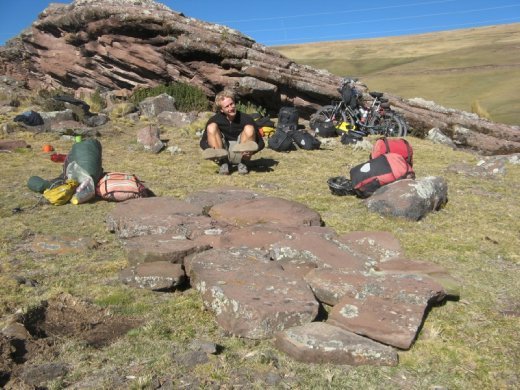
The next morning luckily the sun warms our site. Ali is weak but ok to get up. We have not much food left and the thought of having to spend another night on those stones is not tempting. We pack up slowly and spend an hour taking spines out of our tyres.

Alister gets a small ride up the first pass on the back of a water truck. After that a few more hills around 4200m and then the big down to Lircay. He makes it, and sleeps away the afternoon in a hotel bed.
We do some decision making the next day. Inti Raymi, or the festival of the sun, is on the 24th of june in Cuzco. We would only just make that if we cycle on straight away. But we need some rest and Lircay is not the most exciting of places to do so. We decide to get transport to Ayacucho, still two to three hard days riding away. There are no buses nor combis (a collectivo van), a taxi to the next village would cost us 100 soles (US$40) and the taxis ask us 500 soles ($US$200) all the way to Ayacucho! We are kind of trapped in the valley of Lircay with no easy way out. Lucky enough after 3 hours on the side of the road a pickup passes that will take us all the way for free. It feels a bit weird being in a car and seeing all the beautiful scenery flash by. Big passes, a steep and rocky amazing isolated mountain road. This is our first transport with the bikes in South America so far, but we were in no state to ride it and sometimes we have to give in a little.
So last night we arrived here in Ayacucho. The bikes and bags are covered in grime and dust, almost unrecognizable from what they looked like in Recuay one month ago, and the bikes also took a few knocks and scratches from the rough road (and driving) to get here.
We have a couple of days here to rest and clean them up for the next stretch, the roller coaster between here and Cuzco and Ali is almost back to feeling normal.
Peru is in many ways different to countries we have passed before. First of all the scenery seems in some ways more spectacular every day. The mountains are huge, with sharp craggy peaks or rounded tops, twisted rock, green, red, yellow, black. Desert, jungle and alpine scenery are only a few riding days apart. Since the United States we haven´t felt so in awe of landscapes as here.
The roads go up and down, up and down, and like the roads our feelings about this country go up and down.
We feel about Peruvian people in a similar way, up and down. Peruvians are very upfront and seem keen to talk. Campesinos (farmers) wave to us from their wheat fields, old women herding sheep with a cheek full of coca come for a chat on the roadside, upon entering towns often children run out to greet us and ask ‘where have you come from, where are you going to?’ literally mobbing us on the street. We have been invited inside for dinner and one night after being allowed to camp by the river in a village, the whole village sat next to our tent to watch how we live on the road, how we cook, what we eat and share stories about our different ways of life.

On many occasions the contact on the other hand is not so friendly, in fact at times aggressive and disrespectful. At least, that’s how it comes across to us. Taxi drivers, mototaxis, men on the back of trucks and in general, car drivers open their windows and yell at us ‘gringos’ in a not so pleasant tone. They speed past us inches away on narrow dirt roads, dodging potholes and horn when they are right next to us. Drunk men in towns touch our bikes, ask for money. On quite a few occasions women have offered us their babies or young children. We have had to get used to the ‘gringo price’ for things, quite often paying more for things than locals pay. We already know the answer when we ask them, ‘how much will it be for 2 dinners?’, and they hesitate, think for a while and then say under their breath ‘10 soles’, even though the advertised price is 3 soles per dinner! Opportunists at every corner.
I find it hard often feeling like a bag of money, paying double, triple, sometimes 10 times the price of something, just because our skin colour is white. Or being yelled at on the streets by men, grandmas or from passing cars, pointed at by kids. It is one of the first times in our lives we have felt discrimination based on our appearance. A lot of people tell us that the term ‘gringo’ is not meant to be offensive, but for us it is, and it is the aggressive manner in which it is said or more often yelled at us. Imagine walking down Rundle Mall in Adelaide and pointing and yelling at a Sudanese refugee because he appears different! We wonder where that behaviour is learnt, it is so widespread here in Peru.
It is amazing how different our upbringing and education has made us, how our ideas differ, how hard it is to respect and tolerate one another.
Peru, we love it and then hate it everyday, every hour, every minute. Beautiful, friendly, generous one moment, then dirty, confronting, and opportunistic the next. We have to live with that traveling through by bicycle as well as the ups and downs of the Andes to come. Hopefully we will be the stronger for it! Cesar, you are still our favourite Peruano and we have more good moments than bad of course, we hope you understand?
Until next time, hopefully from the center of the Americas, Cuzco.
Anna and Alister
